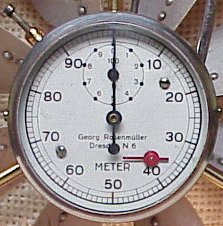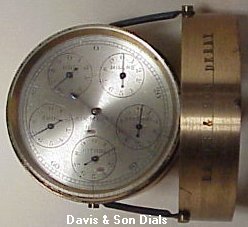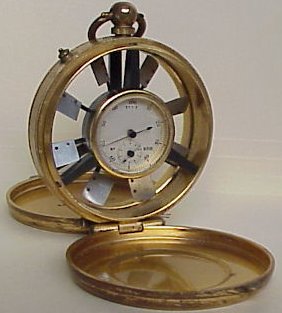ANEMOMETERS
Mechanical anemometers are an instrument used to determine the volume of air entering or exiting mine workings. They were invented by Benjamin Biram, house steward to the Earl Fitzwilliam, owner of numerous collieries in South Yorkshire, England, in 1844.
The formula used most often in mine ventilation using an anemometer was q=av, in which q equals the number of feet of air per minute, a equals the area of the airway in square feet and v equals velocity of air current in feet per minute. Anemometers, as used in mines, were produced in two styles, the Biram style which have the the dials and vanes on the same plane and the offset style which has the dials perpendicular to the vanes.
Anemometers are generally collected by mining collectors and scientific instrument collectors. The earlier models do not have the capability to return-to-zero as later models do. Most have 8 vanes but range from just 4 up to 12 vanes, and have from 1 to 6 dials on the face.
Brass & Copper Georg Rosemuller
Germany
Closeup of Rosenmuller Dials
Queen & Co.
Philadelphia, PA
Queen & Co. Closeup
Queen & Co.
Philadelphia, PA
Negretti & Zambra
London
Negretti & Zambra Closeup
National Mine Service Co.
Davis Instrument Mfg. Co.
Baltimore
Short & Mason
London
John Davis & Co.
Baltimore, MD & Derby England
Short & Mason.
London
Short & Mason Dials
Short & Mason sideview
Julien P. Friez & Sons, Inc. and Davis Instrument Mfg. Co.
John Davis & Sons and Keuffel & Esser
Davis & Son
London & Derby
Casella
London
Casella sideview
Keuffel & Esser Co.
New York
Negretti & Zambra
Short & Mason
London
Keuffel & Esser
New York
Short & Mason Vest Pocket Anemometer
Pocket Watch Size
Porter & Berg
Chicago
R. Fuess
Berlin - Steglitz
R. Feuss
John Davis prototype anemometer, serial number 35
Circa 1845
Exposed gear drive on 1845 Davis Anemometer
Closeup of rather crude dials on Davis 1845 Prototype Anemometer
Side View of Anemometer showing exposed vanes
Engraving: John Davis Optician Derby 35
Engraving: Biram's Patent Anemometer
Keuffel & Esser Co.
New York
Short & Mason Dials





















































